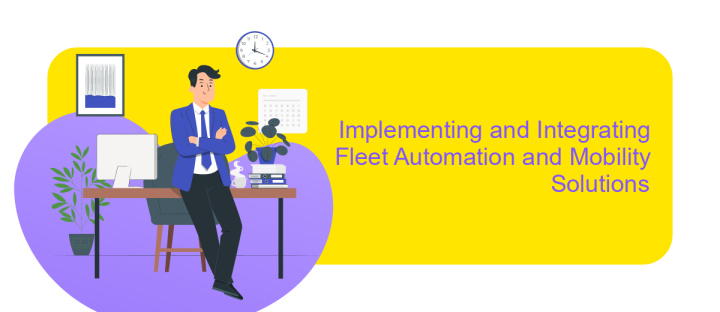Fleet Automation and Mobility Platform
In today's rapidly evolving transportation landscape, fleet automation and mobility platforms are revolutionizing how businesses manage and optimize their vehicle operations. By integrating advanced technologies such as IoT, AI, and data analytics, these platforms offer unparalleled efficiency, cost savings, and safety improvements. This article explores the transformative impact of fleet automation, highlighting key innovations and the future potential of mobility solutions in reshaping industries worldwide.
Introduction to Fleet Automation and Mobility Platforms
Fleet automation and mobility platforms are transforming the way businesses manage their vehicle fleets, offering innovative solutions that enhance efficiency and reduce costs. By integrating advanced technologies such as AI, IoT, and big data analytics, these platforms provide real-time insights and automation capabilities that streamline operations. The result is improved decision-making, optimized resource allocation, and enhanced safety measures, which are crucial for companies aiming to stay competitive in a rapidly evolving market.
- Real-time vehicle tracking and monitoring
- Predictive maintenance and diagnostics
- Route optimization and fuel efficiency
- Enhanced driver safety and compliance
- Data-driven decision-making and reporting
As fleet automation and mobility platforms continue to evolve, they hold the potential to revolutionize the transportation industry. By leveraging these technologies, businesses can not only improve operational efficiency but also contribute to a more sustainable future. The adoption of such platforms is becoming increasingly essential for organizations looking to adapt to changing market demands and environmental regulations, ultimately paving the way for smarter and more sustainable fleet management solutions.
Key Features and Benefits of Fleet Automation

Fleet automation revolutionizes the way businesses manage their vehicle operations by leveraging advanced technologies to streamline processes. One key feature is real-time tracking, which provides managers with up-to-date information on vehicle locations, speeds, and routes. This enables more efficient route planning and reduces fuel consumption. Automated maintenance scheduling is another crucial aspect, ensuring vehicles are serviced on time to prevent breakdowns and extend their lifespan. Additionally, fleet automation enhances safety by monitoring driver behavior and providing instant feedback, helping to reduce accidents and improve overall fleet performance.
The benefits of fleet automation extend beyond operational efficiency. By integrating platforms like ApiX-Drive, businesses can effortlessly connect their fleet management systems with other software solutions, facilitating seamless data exchange and process automation. This integration capability allows for more accurate data analysis and reporting, leading to informed decision-making. Moreover, automation reduces administrative burdens, freeing up valuable time for managers to focus on strategic initiatives. Ultimately, fleet automation not only improves productivity and safety but also contributes to significant cost savings, making it an essential component of modern fleet management strategies.
Types and Applications of Mobility Platforms

Mobility platforms are transforming the way we approach transportation, offering diverse solutions to enhance efficiency, safety, and convenience. These platforms integrate advanced technologies to provide seamless connectivity and real-time data insights, catering to various needs from personal travel to large-scale fleet management.
- Ride-sharing Services: Platforms like Uber and Lyft connect drivers with passengers, offering flexible and cost-effective travel options.
- Car-sharing Networks: Companies such as Zipcar enable users to rent vehicles on-demand, promoting sustainable urban mobility.
- Public Transport Integration: Apps that combine schedules and ticketing for buses, trains, and subways, enhancing commuter experience.
- Fleet Management Systems: Solutions that monitor and optimize the performance of commercial vehicle fleets, reducing operational costs.
- Micromobility Solutions: Services providing bikes and scooters for short-distance travel, reducing traffic congestion and emissions.
As the demand for efficient and eco-friendly transportation grows, mobility platforms continue to evolve, integrating AI and IoT to deliver smarter, more adaptable solutions. These innovations not only improve individual commuting experiences but also contribute to broader environmental and societal benefits.
Implementing and Integrating Fleet Automation and Mobility Solutions

Implementing fleet automation and mobility solutions requires a strategic approach that aligns with organizational objectives. The first step involves assessing current fleet operations to identify areas where automation can enhance efficiency, reduce costs, and improve safety. This assessment should be comprehensive, covering vehicle tracking, maintenance scheduling, and driver management.
Once the assessment is complete, selecting the right technology is crucial. Solutions should be scalable, allowing for future growth and integration with existing systems. It's essential to choose platforms that offer real-time data analytics, enabling informed decision-making and proactive management.
- Conduct a thorough needs analysis.
- Evaluate and select compatible technologies.
- Ensure seamless integration with current systems.
- Train staff on new tools and processes.
Integrating these solutions involves more than just technological implementation; it requires a cultural shift within the organization. Employees must be trained to adapt to new systems, and continuous support should be provided to address challenges. By fostering a culture of innovation and flexibility, organizations can fully leverage the benefits of fleet automation and mobility solutions.
- Automate the work of an online store or landing
- Empower through integration
- Don't spend money on programmers and integrators
- Save time by automating routine tasks
Future Trends and Challenges in Fleet Automation and Mobility
As fleet automation continues to evolve, the integration of AI and IoT technologies is expected to drive significant advancements. These technologies will enable real-time data analysis and predictive maintenance, reducing downtime and operational costs. Additionally, the rise of electric and autonomous vehicles will transform fleet management, requiring new infrastructure and regulatory frameworks. However, the integration of such technologies poses challenges, particularly in terms of cybersecurity and data privacy. Ensuring secure data transmission and protecting sensitive information will be crucial as fleets become more connected.
Another trend shaping the future of fleet automation is the increasing demand for seamless mobility solutions. Platforms like ApiX-Drive play a vital role in facilitating the integration of various services, allowing for streamlined operations and improved efficiency. By automating data transfer between systems, such platforms help fleets adapt to the rapidly changing landscape. However, challenges such as interoperability between different systems and managing the complexity of integrations remain. Addressing these issues will be essential for organizations to fully leverage the benefits of fleet automation and mobility solutions.
FAQ
What is a Fleet Automation and Mobility Platform?
How does Fleet Automation benefit businesses?
Can Fleet Automation integrate with existing systems?
What features should I look for in a Mobility Platform?
How can I ensure data security in a Fleet Automation Platform?
Do you want to achieve your goals in business, career and life faster and better? Do it with ApiX-Drive – a tool that will remove a significant part of the routine from workflows and free up additional time to achieve your goals. Test the capabilities of Apix-Drive for free – see for yourself the effectiveness of the tool.


